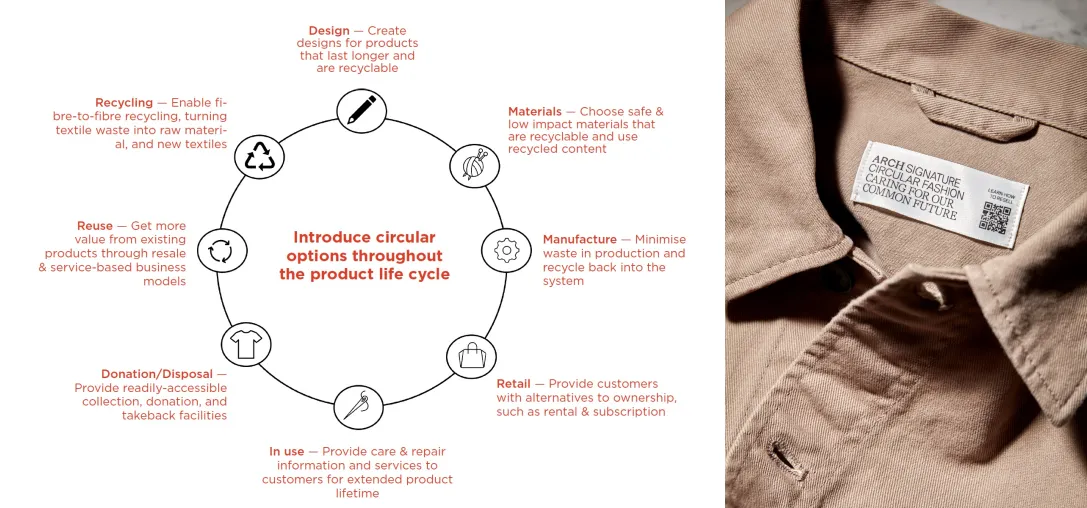The Digital Product Passport (DPP) is a comprehensive digital record that captures detailed information about a product from its production phase to its end-of-life stage. It serves as a valuable resource for multiple stakeholders, including manufacturers, suppliers, retailers, consumers, and regulatory authorities. In the textile industry, DPP brings significant advantages, including enhanced transparency, increased consumer confidence, improved supply chain visibility, and the promotion of circular economy practices.
What Is A Digital Product Passport?
The Digital Product Passport (DPP) is among several initiatives introduced by the European Commission as part of their commitment to fostering sustainability in Europe. It is just a fraction of a larger and more extensive undertaking known as the European Green Deal.
A DPP is a digital record or document that contains comprehensive information about a specific product throughout its lifecycle. It serves as a centralized repository of data related to the product, enabling easy access to relevant details for various stakeholders, including manufacturers, suppliers, retailers, consumers, and regulatory authorities. At present, the European Union is evaluating the potential implementation of product passports in three specific sectors by the year 2026: Apparel, Battery, and Consumer Electronics.
For textile industry, DPP contains detailed information about the textile product’s characteristics, composition, origin, manufacturing processes, environmental impact, certifications, and other relevant data. Key information typically included in a DPP for textiles may encompass the fiber composition, fabric construction, dyeing and finishing processes, compliance with social and environmental standards, energy and water consumption during production, information on fair trade practices, and guidance for proper care and disposal.

Who & When Will Need To Implement The Digital Product Passport?
DPP Implementation Timeline
The timeline for the implementation of Digital Product Passport can be outlined as follows: In 2023, the focus lies on establishing basic product data requirements. During this period, efforts are made to define the essential information that should be included in the passports. By 2027, there is an anticipated legislative release period, wherein specific regulations or laws related to DPP are expected to be enacted.
Finally, in 2030, the full rollout of DPP is projected to take place, encompassing widespread implementation across various industries and sectors. This phased approach allows for the necessary groundwork, legal frameworks, and subsequent comprehensive adoption of DPP.

Digital Product Passport enables circularity
Entities Envisaged to Implement DPP
The implementation of the Digital Product Passport can involve various stakeholders across the supply chain and regulatory landscape. The specific entities that may need to implement Digital Product Passports can include:
Manufacturers and Producers: Manufacturers and producers of products will typically be responsible for implementing Digital Product Passports for the products they create. This includes ensuring that the necessary information and data are collected, recorded, and made accessible through the passport.
Suppliers and Distributors: Suppliers and distributors within the supply chain may also play a role in implementing Digital Product Passports. They may need to ensure the accurate transfer of information and support the integration of passports into their processes.
Retailers: Retailers who sell products to consumers may be required or encouraged to adopt Digital Product Passports. This enables them to provide transparent information to their customers about the products they offer.
Regulatory Bodies: Government entities and regulatory bodies may mandate the implementation of Digital Product Passports within specific industries or product categories. They may set regulations or standards that guide the implementation process and ensure compliance.
Industry Associations and Initiatives: Industry associations and sector-specific initiatives often play a role in encouraging or facilitating Digital Product Passport implementation. They do this by incorporating it into their sustainability or transparency initiatives.
How DPP Means To Garment Industry?
Transparency and Consumer Confidence: Digital Product Passports enable brands and manufacturers to provide detailed information about the apparel’s materials, production processes, and environmental impact. This transparency builds consumer trust, allowing them to make informed choices and support brands that align with their values.
Supply Chain Visibility and Traceability: Digital Product Passports facilitate end-to-end visibility and traceability throughout the apparel supply chain. This helps in identifying and addressing issues related to labor conditions, environmental practices, and social responsibility, thereby promoting ethical and sustainable sourcing.
Circular Economy and Recycling: By including information on recyclability, material composition, and proper disposal, Digital Product Passports encourage the adoption of circular economy practices. They support efforts to increase recycling rates, reduce textile waste, and promote the reuse or recycling of apparel products.

Counterfeit Prevention: Digital Product Passports have the capability to include unique identifiers or anti-counterfeiting measures. These features serve to authenticate genuine products effectively. Additionally, they help in combating the widespread issue of counterfeit apparel items.
Product Performance and Quality Assurance: Digital Product Passports can include information on product testing, performance standards, and quality certifications. This ensures that consumers have access to reliable information about the durability, safety, and overall quality of the apparel they purchase.
Compliance with Regulations: Digital Product Passports support apparel brands and manufacturers in adhering to evolving regulations and standards. These encompass various aspects like product safety, chemical restrictions, environmental regulations, and social compliance.
What Are Challenges?
One of the greatest challenges in relation to Digital Product Passport is the establishment of standardized data collection and information sharing processes. Ensuring uniform collection, validation, and sharing of accurate product information is a considerable challenge. This challenge involves various stakeholders, such as manufacturers, suppliers, retailers, and regulatory bodies. They all need to collaborate effectively to achieve this goal.
This challenge involves addressing issues such as data accuracy, consistency, interoperability, and data privacy. Harmonizing data formats is crucial. Defining common data fields is equally important. Additionally, establishing secure data sharing protocols plays a vital role. These actions collectively enable the seamless integration and interoperability of Digital Product Passports. This integration spans across diverse industries and regions.
Additionally, implementing the necessary infrastructure and technologies to support the creation, storage, and access of Digital Product Passports can be complex and resource-intensive. This may require investments in digital systems, connectivity, and data management solutions, especially for smaller businesses or industries with limited technological capabilities.
Furthermore, gaining widespread adoption and acceptance of Digital Product Passports by all stakeholders in the supply chain requires collaboration, education, and awareness. Recognition of the value and benefits of Digital Product Passports among manufacturers, retailers, and consumers is vital. It’s equally important that these stakeholders are willing to invest the necessary time and resources into their effective implementation. The willingness to invest in implementation and utilization is a critical aspect.

















